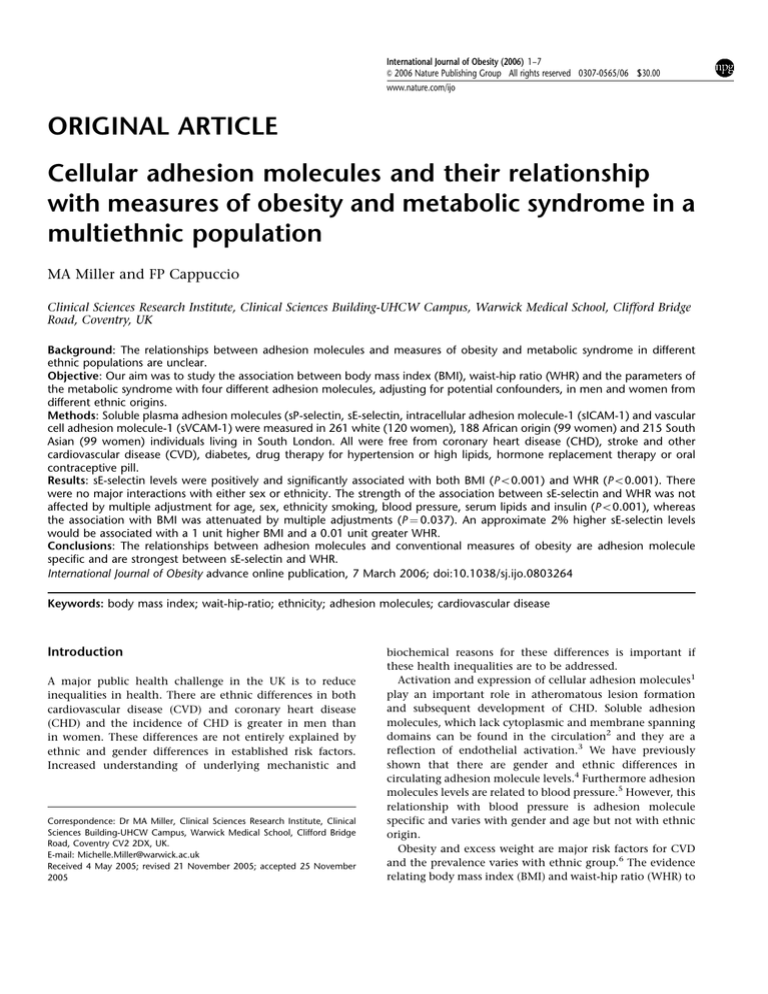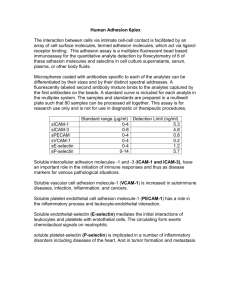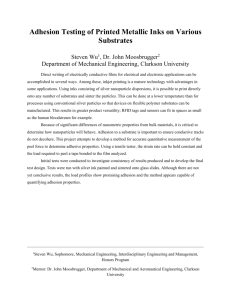Document 12776676
advertisement

International Journal of Obesity (2006) 1–7 & 2006 Nature Publishing Group All rights reserved 0307-0565/06 $30.00 www.nature.com/ijo ORIGINAL ARTICLE Cellular adhesion molecules and their relationship with measures of obesity and metabolic syndrome in a multiethnic population MA Miller and FP Cappuccio Clinical Sciences Research Institute, Clinical Sciences Building-UHCW Campus, Warwick Medical School, Clifford Bridge Road, Coventry, UK Background: The relationships between adhesion molecules and measures of obesity and metabolic syndrome in different ethnic populations are unclear. Objective: Our aim was to study the association between body mass index (BMI), waist-hip ratio (WHR) and the parameters of the metabolic syndrome with four different adhesion molecules, adjusting for potential confounders, in men and women from different ethnic origins. Methods: Soluble plasma adhesion molecules (sP-selectin, sE-selectin, intracellular adhesion molecule-1 (sICAM-1) and vascular cell adhesion molecule-1 (sVCAM-1) were measured in 261 white (120 women), 188 African origin (99 women) and 215 South Asian (99 women) individuals living in South London. All were free from coronary heart disease (CHD), stroke and other cardiovascular disease (CVD), diabetes, drug therapy for hypertension or high lipids, hormone replacement therapy or oral contraceptive pill. Results: sE-selectin levels were positively and significantly associated with both BMI (Po0.001) and WHR (Po0.001). There were no major interactions with either sex or ethnicity. The strength of the association between sE-selectin and WHR was not affected by multiple adjustment for age, sex, ethnicity smoking, blood pressure, serum lipids and insulin (Po0.001), whereas the association with BMI was attenuated by multiple adjustments (P ¼ 0.037). An approximate 2% higher sE-selectin levels would be associated with a 1 unit higher BMI and a 0.01 unit greater WHR. Conclusions: The relationships between adhesion molecules and conventional measures of obesity are adhesion molecule specific and are strongest between sE-selectin and WHR. International Journal of Obesity advance online publication, 7 March 2006; doi:10.1038/sj.ijo.0803264 Keywords: body mass index; wait-hip-ratio; ethnicity; adhesion molecules; cardiovascular disease Introduction A major public health challenge in the UK is to reduce inequalities in health. There are ethnic differences in both cardiovascular disease (CVD) and coronary heart disease (CHD) and the incidence of CHD is greater in men than in women. These differences are not entirely explained by ethnic and gender differences in established risk factors. Increased understanding of underlying mechanistic and Correspondence: Dr MA Miller, Clinical Sciences Research Institute, Clinical Sciences Building-UHCW Campus, Warwick Medical School, Clifford Bridge Road, Coventry CV2 2DX, UK. E-mail: Michelle.Miller@warwick.ac.uk Received 4 May 2005; revised 21 November 2005; accepted 25 November 2005 biochemical reasons for these differences is important if these health inequalities are to be addressed. Activation and expression of cellular adhesion molecules1 play an important role in atheromatous lesion formation and subsequent development of CHD. Soluble adhesion molecules, which lack cytoplasmic and membrane spanning domains can be found in the circulation2 and they are a reflection of endothelial activation.3 We have previously shown that there are gender and ethnic differences in circulating adhesion molecule levels.4 Furthermore adhesion molecules levels are related to blood pressure.5 However, this relationship with blood pressure is adhesion molecule specific and varies with gender and age but not with ethnic origin. Obesity and excess weight are major risk factors for CVD and the prevalence varies with ethnic group.6 The evidence relating body mass index (BMI) and waist-hip ratio (WHR) to Soluble adhesion molecules and obesity MA Miller and FP Cappuccio 2 specific adhesion molecule levels is unclear. Some studies have shown a positive correlation between intracellular adhesion molecule-1 (sICAM-1) and BMI7,8 and sICAM-1 and WHR9 whereas others have not.4,10–12 sE-selectin is also related to BMI or WHR in some4,7,12 but not all studies.11 The aim of this study was to explore these relationships more fully in a multiethnic population sample. Materials and methods Subjects We studied 664 individuals from the Wandsworth Heart and Stroke Study, as described in detail elsewhere.13,14 The subjects were not on hypertension or lipid-lowering medications and not taking the oral contraceptive pill or hormone replacement therapy and they did not have any previous medical history of ischaemic heart disease or stroke. Of the individuals studied, 261 were white (120 women), 188 were of African origin (99 women) and 215 were of South Asian origin (99 women). The Local Ethics Committee approved the study. All participants gave their informed consent to participate. cially available ELISA kits (R&D systems Europe Ltd, Abingdon, UK.4 Biochemical measurements were performed as described previously.13,14 Statistical analysis Plasma levels of sE-selectin, sP-selectin, sVCAM-1 and sICAM-1 were all positively skewed.5 Therefore, analyses were performed on log-transformed data. Differences between groups (with described adjustments) were tested using analysis of covariance. Tertiles of BMI or WHR were determined for each gender and ethnic subgroup separately. Results are presented as geometric means and 95% confidence intervals (CI). General Linear Models with BMI or WHR as the independent variable were used to estimate the relationship with the adhesion molecules, adjusting for confounding. Interaction test was used to compare slopes between groups. Slopes (and 95% CI) were then exponentiated and expressed as % change in adhesion molecule levels for a given change in BMI or WHR. Given the degree of multiple testing, only a P-value p0.005 (Bonferroni’s correction) was considered statistically significant. Results Methods Blood was taken between 0800 and 1200 hours from seated subjects who had fasted overnight and had refrained from smoking or taking vigorous exercise.13,14 Height and weight were taken and BMI calculated and expressed as kg/m2. Blood pressure was taken with standard methods and an automated recorder.13,14 Adhesion molecule (sE-selectin, sP-selectin, sICAM-1 and vascular cell adhesion molecule-1 (sVCAM-1)) measurements were performed using commer- Table 1 Detailed characteristics of the population have been reported previously13,14 and a summary of some of the variables of interest are given in Table 1. The associations between adhesion molecules and cardiovascular risk factors (adjusted for age, sex and smoking) in each ethnic group and then adjusted for ethnicity as well are shown in Table 2. sE-selectin levels were significantly related to BMI in each ethnic group, sVCAM-1 levels were related to Age and sex adjusted characteristics of 664 men and women aged 40–59 years of different ethnic groups living in Wandsworth, South London, 1994–1996 White (n ¼ 261) South Asian (n ¼ 215) African origin (n ¼ 188) P Body mass index (kg/m ) Waist-hip ratio 25.7 (25.2–26.2) 0.855 (0.847–0.863) 25.5 (24.9–26.1) 0.880 (0.872–0.889) 27.3 (26.7–27.9) 0.865 (0.855–0.874) o0.001 o0.001 Smoking Current (%) Ex (%) Never (%) Systolic blood pressure (mm Hg) Diastolic blood pressure (mm Hg) HDL cholesterol (mmol/l) Serum triglycerides (mmol/l)a Serum insulin (mU/l)a 29 37 33 123.4 78.8 1.43 1.10 6.8 16 7 77 125.8 81.6 1.21 1.33 10.4 15 13 72 127.1 83.0 1.49 0.77 7.8 2 Soluble adhesion molecule levels sE-selectin (ng/ml)a sP-selectin (ng/ml)a sICAM-1 (ng/ml)a sVCAM-1 (ng/ml)a o0.001 45.4 72 274 432 (24–35) (31–43) (27–39) (121.3–125.6) (77.6–80.0) (1.38–1.47) (1.04–1.16) (6.4–7.3) (43.9–47.8) (69–75) (263–286) (418–446) 46.5 72 267 439 (11–21) (4–10) (71–83) (123.5–128.2) (80.3–83.0) (1.16–1.25) (1.26–1.42) (9.6–11.3) (43.9–49.2) (68–75) (255–280) (424–455) 46.4 57 189 386 (10–21) (8–17) (66–78) (124.6–129.6) (81.6–84.4) (1.43–1.54) (0.73–0.83) (7.2–8.5) 0.081 o0.001 o0.001 o0.001 o0.001 (43.8–49.3) (55–61) (180–199) (372–401) 0.790 o0.001 o0.001 o0.001 Results are means or percentages (95% CI). P-values are for test of heterogeneity between ethnic groups by analysis of covariance or w2 statistics. There were no more than two values missing from any cell. aGeometric means. International Journal of Obesity Soluble adhesion molecules and obesity MA Miller and FP Cappuccio 3 Table 2 Partial correlation coefficients of associations (adjusted for age, sex and smoking (a, b and c)) and adjusted for age, sex, smoking and ethnicity (d) between cellular adhesion molecules and cardiovascular risk factors in (a) 261 white (b) 215 South Asian (c) 188 African and, (d) 664 total group of men and women from the Wandsworth Heart and Stroke Study (WHSS) Body mass index Whites sE-selectina sP-selectina sICAM-1a sVCAM-1a 0.23*** 0.05 0.12 0.21*** South Asian sE-selectina sP-selectina sICAM-1a sVCAM-1a 0.18** 0.02 0.16* 0.08 African Origin sE-selectina sP-selectina sICAM-1a sVCAM-1a 0.16* 0.01 0.03 0.10 Total group sE-selectina sP-selectina sICAM-1a sVCAM-1a 0.19*** 0.03 0.02 0.04 Waist-hip ratio Systolic BP 0.21*** 0.01 0.13* 0.12 0.20*** 0.11 0.05 0.01 0.28*** 0.09 0.20** 0.09 0.13 0.06 0.02 0.03 0.21*** 0.01 0.09* 0.08* Diastolic BP HDL-cholesterol Serum triglyceridesa 0.09 0.06 0.16* 0.21*** 0.26*** 0.12 0.08 0.04 0.20*** 0.13* 0.12 0.05 0.18** 0.02 0.10 0.04 0.20** 0.01 0.03 0.01 0.06 0.10 0.10 0.13 0.19** 0.06 0.06 0.01 0.12 0.16* 0.08 0.08 0.07 0.08 0.09 0.01 0.16* 0.10 0.02 0.04 0.24*** 0.04 0.04 0.02 0.17*** 0.08* 0.04 0.03 0.09* 0.12** 0.14*** 0.17*** 0.19*** 0.03 0.002 0.01 Serum fasting insulina 0.17** 0.03 0.11 0.04 0.24*** 0.13 0.16* 0.01 0.22** 0.06 0.10 0.06 0.18*** 0.17*** 0.20*** 0.08* 0.20*** 0.07 0.05 0.02 a 60.0 55.0 50.0 45.0 40.0 35.0 20 25 30 35 BMI tertiles b 60.0 sE-selectin (ng/mL) BMI in whites and sICAM-1 levels were related to BMI in South Asians. Waist-hip ratio was significantly related to sEselectin levels in Whites and South Asians. This was not significant in individuals of African origin. sICAM-1 levels were also related to WHR in whites and South Asians. Further analysis, however, demonstrated that there was no interaction with gender or ethnicity (interaction test was not significant). This indicates that observed associations are consistent across gender and ethnic groups. The associations for the total group adjusted for age, sex, smoking and ethnicity are therefore also shown in Table 2. The strongest and most consistent relationship is between both BMI and WHR with sE-selectin. These results are shown in Figure 1 and the results for the total group in Figure 2. sE-selectin was significantly associated not only with measures of obesity but also with blood pressure and other components of the metabolic syndrome. Further analyses were therefore performed using multiple adjustments for these potential confounders. Following adjustments for age, sex, smoking and ethnicity sE-selectin was the only adhesion molecule to show a strong and significant relationship with both BMI (2.0% (95% C.I. 1.2–2.7) increase per unit of higher BMI; Po0.001) and WHR (2.6% (1.3–4.8) increase per 0.01 unit of higher WHR) (Table 3). No interactions were detected with sex or ethnicity (Table 3). The strong association with WHR was still present following further adjustment for blood pressure and other parameters related to the metabolic syndrome (lipids – HDL-cholesterol or Triglycerides) and fasting insulin levels). However, the relationship between sE-selectin (ng/mL) *Pp0.05, **Pp0.01, ***Pp0.001. aAnalysis has been performed on Loge transformed data. 55.0 50.0 45.0 40.0 35.0 0.75 0.8 0.85 0.9 WHR tertiles 0.95 1 Figure 1 sE-selectin levels, adjusted for age, sex, ethnicity, and smoking by (a) ethnic specific tertiles of BMI and (b) ethnic specific tertiles of WHR, in whites (triangle), South Asians (squares) and individuals of African origin (circles). Results are geometric means and 95% CI. (whites: (n ¼ 261): BMI Po0.001; WHR P ¼ 0.024), (South Asians (n ¼ 215) BMI Po0.001; WHR Po0.001), (African origin (n ¼ 188) BMI P ¼ 0.444; WHR P ¼ 0.083). International Journal of Obesity Soluble adhesion molecules and obesity MA Miller and FP Cappuccio a 60.0 sE-selectin (ng/mL) 4 55.0 sE-selectin and BMI was attenuated following these adjustments (P ¼ 0.037 in Model 6) (Table 3). Addition of social class to Model 1 did not affect the outcome of the analysis (sE-selectin: BMI 2.2% (1.4–3.0); Po0.001; WHR 3.2% (1.6–5.9); Po0.001). p<0.001 (n=222) (n=215) 50.0 (n=226) 45.0 Discussion 40.0 Our study shows that conventional measures of obesity (BMI and WHR) are related to adhesion molecule levels but that, following adjustment for potential confounders, the stongest association is with sE-selectin, and it is constant across genders and ethnic groups. Obesity, defined as a BMI of greater than 30 kg/m2 and excess weight is related to economic, behavioural, molecular, cellular and metabolic parameters.15 Moreover, this complex multifaceted condition is linked to CVD risk and is becoming a major public health issue. The metabolic syndrome is also associated with an increased CHD risk and an increased risk of diabetes.16 It is characterised by the clustering of cardiovascular and metabolic risk factors in a given individual. These include the presence of central obesity, an adverse lipid profile (high triacyglycerols and low HDLcholesterol), raised blood pressure and insulin resistance or glucose intolerance. It has also been suggested that there may be an increased proinflammatory state.16 35.0 20 25 30 35 BMI tertiles b 60.0 sE-selectin (ng/mL) P<0.001 (n=200) 55.0 (n=220) 50.0 (n=244) 45.0 40.0 35.0 0.75 0.8 0.85 0.9 0.95 1 WHR tertiles Figure 2 sE-selectin levels in total group by (a) tertiles of BMI and (b) tertiles of WHR. Adjusted for age, sex, ethnicity, and smoking. Results are geometric means and 95% CI. Table 3 Relationship between BMI or WHR and adhesion molecule concentrations in individuals from the WHSS BMI Interaction Interaction P Sex Ethnicity Model 1: age, sex, ethnicity, smoking sE-selectin 2.0 1.2 to 2.7 sP-selectin 0.1 0.6 to 0.7 sICAM-1 0.5 0.1 to 1.1 sVCAM-1 0.5 0.0 to 0.9 o0.001 0.816 0.131 0.061 0.260 0.632 0.422 0.374 0.707 0.831 0.170 0.026 Model 2: model 1+systolic blood pressure sE-selectin 1.7 0.9 to 2.4 sP-selectin 0.1 0.8 to 0.5 sICAM-1 0.4 0.3 to 1.0 sVCAM-1 0.4 0.1 to 0.9 o0.001 0.749 0.266 0.090 Model 3: model 1+diastolic blood pressure sE-selectin 1.6 0.8 to 2.4 sP-selectin 0.1 0.7 to 0.6 sICAM-1 0.4 0.3 to 1.0 sVCAM-1 0.5 0.0 to 1.0 Effect (%)a (95% CI) WHR Effect (%)a Interaction Interaction (95% CI) P Sex Ethnicity 1.3 to 4.8 0.3 to 0.5 0.07 to 1.3 0.01 to 0.8 o0.001 0.909 0.022 0.044 0.408 0.105 0.240 0.226 0.264 0.122 0.834 0.569 2.0 0.1 0.5 0.3 0.8 to 3.8 0.4 to 0.3 0.02 to 1.2 0.02 to 0.8 o0.001 0.572 0.065 0.070 o0.001 0.820 0.269 0.067 1.8 0.1 0.5 0.4 0.8 to 3.6 0.4 to 0.4 0.01 to 1.2 0.002 to 0.9 o0.001 0.714 0.057 0.048 Model 4: model 3+high density lipoprotein (HDL) sE-selectin 1.3 0.5 to 2.0 0.001 1.5 0.5 to 3.1 o0.001 Model 5: model 4+insulin sE-selectin 1.0 0.1 to 1.8 0.032 1.1 0.3 to 2.5 0.004 Model 6: model 3+triglycerides+insulin sE-selectin 0.9 0.1 to 1.8 0.037 0.9 0.1 to 2.2 o0.001 2.6 0.02 0.6 0.4 Highly significant values of P are shown in bold typeface. Abbreviations: BMI, body mass index; WHR, waist-hip-ratio; CI, confidence interval; s, soluble; ICAM-1, intercellular adhesion molecule-1; VCAM-1, vascular cell adhesion molecule-1. aPercentage increase in adhesion molecule concentrations per unit change in BMI or 0.01 change in WHR. International Journal of Obesity Soluble adhesion molecules and obesity MA Miller and FP Cappuccio 5 Cellular adhesion molecules are important in the development of atherosclerosis. The transcription of these molecules, proinflammatory cytokines and reactive oxygen species is governed by the transcription factor nuclear factor kappa B (NF-kB).17 It is, however, of interest that insulin resistance is associated with atherosclerotic pathways but that insulin has been shown to inhibit NF-kB,18 suggesting that insulin may have an anti-inflammatory role. We have previously shown that there are ethnic differences in circulating adhesion molecule levels, in that circulating levels are reduced in individuals of African origin4 and that these differences are maintained after adjustment for ethnic differences in cardiovascular risk factors. In addition, we have previously demonstrated that not only are sP-selectin levels significantly lower in individuals of African origin compared to whites but that the levels are significantly different in Caribbean (62 (59–67) ng/ml n ¼ 111) compared to West African individuals (51 (47–55) ng/ml; n ¼ 77).4 We have also demonstrated that although the Thr715Pro P-selectin gene polymorphism is associated with lower sP-selectin levels it does not determine the lower levels of sP-selectin observed in blacks, in whom the C allele is very rare.19 The incidence of cardiovascular events varies between West African and Caribbean individuals and these results do not preclude the fact that sP-selectin may be important in atherogenesis and thrombosis. As we have previously shown, adhesion molecules levels are related to blood pressure and gender and to parameters of the metabolic syndrome.4,5 Table 2 indicates that there are strong relationships with adhesion molecule levels and cardiovascular risk factors, which are adhesion molecule specific. Some variation with ethnicity was also observed. However, in a previous in-depth analysis of the relationship between blood pressure and adhesion molecule we reported that the relationship was indeed adhesion molecule specific but that although it varied with age and gender it did not with ethnic origin.5 Similarly, in this analysis we have shown that the relationship between sE-selectin and both BMI and WHI is not significantly different by ethnic group (Table 3). The present analysis explores in greater detail the independent contribution of conventional measures of obesity to the variation in the levels of different adhesion molecules, allowing for confounding factors. sE-selectin showed the strongest and more robust association with measures of obesity and other cardiovascular risk factors. However, the present relationship with obesity is independent of the effect on blood pressure and other cardiovascular risk factors as it is maintained after multiple adjustments (Table 3). The characteristics of the Metabolic Syndrome include the presence of obesity and insulin resistance whereby the body mounts a supranormal insulin response to a glucose load.20 It has been suggested that inflammation may play an important role in the development of obesity, insulin resistance and metabolic syndrome and it is important to understand the mechanisms which may be involved. The transcription of proinflammatory molecules is governed by NF-kB, which in turn has recently been shown to be increased by the consumption of a mixed meal.21 By contrast, insulin has recently been shown to suppress the proinflammatory transcription factor NF-kB as well as plasma concentrations of ICAM-1.19 If then the action of insulin is impaired, as in ‘insulin resistance’, the suppression of the proinflammatory risk factors would also be impaired.20 In our study, there was a positive association between insulin and sE-selectin levels. However, the strength of the association between sE-selectin and WHR was not affected by multiple adjustments including the addition of insulin to the model. By contrast, the association with BMI was attenuated by multiple adjustments and in particular the addition of insulin to the model (P ¼ 0.032). This indicates that while there is a positive association between sE-selectin and insulin, the attenuation of the relationship between BMI and sE-selectin by insulin points to an important effect on this relationship, which may be anti-inflammatory in nature. There are important ethnic differences in diabetes prevalence and insulin sensitivity. Nevertheless, the association between sE-selectin and insulin was consistent across ethnic groups. Likewise, no ethnic differences in the associations between sE-selectin and BMI or WHI were observed. As well as the association between genetic, physiological, metabolic and cellular influences, and the development of obesity, economic and social factors are also important. We therefore looked at the effect of social class on the relationship between adhesion molecules and measures of obesity. The addition of social class to our models did not affect the outcome of the analysis (sE-selectin (Model 1): BMI 2.2% (1.4–3.0); Po0.001; WHR 3.2% (1.6–5.9); Po0.001). Our major findings are consistent with previous studies in the literature. Ito et al.22 showed that in obese women baseline measures of sE-selectin but not those of sICAM-1 were associated with measures of fat mass. Our data support the idea that each different adhesion molecule has a specific role in the adhesion pathway. Leukocyte rolling and platelet–leukocyte interaction is mediated by the selectins whereas firm attachment to, and subsequent migration through, the endothelium requires the expression of ICAM-1 and VCAM.23 The source and mode of expression of these molecules also differ. ICAM-1 and VCAM-1 are found on the surface of macrophages and endothelial cells. sP-selectin is found in storage granules in platelets and endothelial cells, it is expressed on activated endothelial cells and platelets, while its major ligand PSGL-1 is expressed on leukocytes.24 sE-selectin, however, is only of endothelial origin and is rapidly synthesised in response to endothelial activation.23 Endothelial dysfunction has been identified as an early marker of CVD. Moreover, a healthy endothelium proactively inhibits proatherogenic processes by nitric oxide pathways. Although the exact mechanism relating adhesion International Journal of Obesity Soluble adhesion molecules and obesity MA Miller and FP Cappuccio 6 molecules to obesity is unknown, evidence suggests that endothelial activation is important. There is a relationship between TNF-a, BMI and endothelin-1 in obese subjects suggesting that obesity may induce a low-grade inflammatory response, induce endothelial dysfunction, increase insulin resistance and therefore promote the development of CVD.25 Moreover, body fat distribution is correlated with endothelial dysfunction as determined by flow-mediated dilatation.26 Dandona et al.27 demonstrated that obesity was associated with an increase in plasma TNF-a levels and that weight loss was associated with a concomitant decrease in both the expression and secretion of TNF-a. The resulting fall in the level of TNF-a may contribute to the improvement in insulin resistance observed following weight loss. Finally, weight reduction following dietary22 and surgical intervention28 results in a significant decrease in both sEselectin and sICAM-1 levels. Interestingly, the first study demonstrated that while the changes in sE-selectin were significantly associated with changes in total body fat mass those in sICAM-1 were not.22 Furthermore, the second study which used gastric banding, demonstrated that weight loss was associated with a change in sE-selectin levels 6 and 12 months after surgery but, lower levels of sICAM-1 were only seen at 6 months. No changes were observed in sVCAM-1 levels.28 The results indicate that different mechanisms govern the short and long-term processes and that the effects on E-selectin may indicate that weight reduction might indeed by associated with a long-term improvement in endothelial function. Taken together, the evidence is compatible with an important role that endothelial activation may play in explaining the association between sE-selectin and measures of obesity. Further studies are needed to understand these processes and to open opportunities for treatment either through diet or pharmacological interventions. Acknowledgements A list of the WHSS Group is given elsewhere.14 The study has received support from the former Wandsworth and South Thames Regional Health Authorities, NHS R&D Directorate, British Heart Foundation, former British Diabetic Association and The Stroke Association. This study was supported by the British Heart Foundation (Project Grant PG/2001023). There are no conflicts of interest or any disclaimers. References 1 Krieglstein CF, Granger DN. Adhesion molecules and their role in vascular disease. Am J Hypertens 2001; 14: 44S–54S. 2 Pigott R, Dillon LP, Hemingway IH, Gearing AJ. Soluble forms of E-selectin, ICAM-1 and VCAM-1 are present in the supernatants of cytokine activated cultured endothelial cells. Biochem Biophys Res Commun 1992; 187: 584–589. International Journal of Obesity 3 Leeuwenberg JF, Smeets EF, Neefjes JJ, Shaffer MA, Cinek T, Jeunhomme TM et al. E-selectin and intercellular adhesion molecule-1 are released by activated human endothelial cells in vitro. Immunology 1992; 77: 543–549. 4 Miller MA, Sagnella GA, Kerry SM, Strazzullo P, Cook DG, Cappuccio FP. Ethnic differences in circulating soluble adhesion molecules. The Wandsworth heart and stroke study. Clin Sci (London) 2003; 104: 591–598. 5 Miller MA, Kerry SM, Cook DG, Cappuccio FP. Cellular adhesion molecules and blood pressure: interaction with sex in a multiethnic population. J Hypertens 2004; 22: 705–711. 6 Cappuccio FP. Ethnicity and cardiovascular risk: variations in people of African ancestry and South Asian origin. J Hum Hypertens 1997; 11: 571–576. 7 Hwang SJ, Ballantyne CM, Sharrett AR, Smith LC, Davis CE, Gotto Jr AM et al. Circulating adhesion molecules VCAM-1, ICAM-1, and E-selectin in carotid atherosclerosis and incident coronary heart disease cases: the Atherosclerosis Risk in Communities (ARIC) study. Circulation 1997; 96: 4219–4225. 8 Ferri C, Desideri M, Valenti M, Bellini C, Pasin M, Santucci A et al. Early upregulation of endothelial adhesion molecules in obese hypertensive men. Hypertension 1999; 34: 568–573. 9 Demerath E, Towne B, Blangero J, Siervogel RM. The relationship of soluble ICAM-1, VCAM-1, P-selectin and E-selectin to cardiovascular disease risk factors in healthy men and women. Ann Human Biol 2001; 28: 664–678. 10 Rohde LE, Hennekens CH, Ridker PM. Cross-sectional study of soluble intercellular adhesion molecule-1 and cardiovascular risk factors in apparently healthy men. Arterioscler Thromb Vasc Biol 1999; 19: 1595–1599. 11 DeSouza CA, Dengel DR, Macko RF, Cox K, Seals DR. Elevated levels of circulating cell adhesion molecules in uncomplicated essential hypertension. Am J Hypertens 1997; 10: 1335–1341. 12 Ponthieux A, Herbeth B, Droesch S, Haddy N, Lambert D, Visvikis S. Biological determinants of serum ICAM-1, E-selectin, P-selectin and L-selectin levels in healthy subjects: the Stanislas study. Atherosclerosis 2004; 172: 299–308. 13 Cappuccio FP, Cook DG, Atkinson RW, Strazzullo P. Prevalence, detection, and management of cardiovascular risk factors in different ethnic groups in south London. Heart 1997; 78: 555–563. 14 Cappuccio FP, Cook DG, Atkinson RW, Wicks PD. The Wandsworth Heart & Stroke Study. A population-based survey of cardiovascular risk factors in different ethnic groups. Methods and baseline findings. Nutr Metab Cacrdiovasc Dis 1998; 8: 371–385. 15 National Institutes of Health. Clinical guidelines on the identification, evaluation and treatment of overweight and obesity in adults: the evidence report. National Heart, Lung and Blood Institute in cooperation with the National Institutes of Diabetes and Digestive and Kidney Diseases, Rockville, MD. Publication No. 98-4083 1998. 16 Vega GL. Obesity and the metabolic syndrome. Minerva Endocrinol 2004; 29: 47–54. 17 Barnes PJ, Karin M. Mechanisms of disease: nuclear factor-kB – a pivotal transcription factor in chronic inflammatory diseases. N Engl J Med 1997; 336: 1066–1071. 18 Dandona P, AlJada A, Mohanty P, Ghanim H, Hamouda W, Assian E et al. Insulin inhibits intranuclear nuclear factor kB and stimulates IkB in mononuclear cells in obese subjects: evidence for an anti-inflammatory effect? J Clin Endocrinol Metab 2001; 86: 3257–3265. 19 Miller MA, Kerry SM, Dong Y, Strazzullo P, Cappuccio FP. Association between the Thr715Pro P-selectin gene polymorphism and soluble P-selectin levels in a multiethnic population in South London. Thromb Haemost 2004; 5: 1060–1065. 20 Dandona P, Aljada A, Chaudhuri A, Mohanty P, Garg R. Metabolic syndrome: a comprehensive perspective based on interactions Soluble adhesion molecules and obesity MA Miller and FP Cappuccio 7 21 22 23 24 between obesity, diabetes, and inflammation. Circulation 2005; 111: 1448–1454. Aljada A, Mohanty P, Ghanim H, Abdo T, Devjit T, Chaudhuri A et al. Increase in intranuclear nuclear factor kB and decrease in inhibitor kB in mononuclear cells after a mixed meal: evidence for a proinflammatory effect. Am J Clinical Nutrition 2004; 79: 682–690. Ito H, Ohshima A, Inoue M, Ohto N, Nakasuga K, Kaji Y et al. Weight reduction decreases soluble cellular adhesion molecules in obese women. Clin Exp Pharmacol Physiol 2002; 29: 399–404. Chia MC. The role of adhesion molecules in atherosclerosis. Crit Rev Clin Lab Sci 1998; 35: 573–602. Furie B, Furie BC. Role of platelet P-selectin and microparticle PSGL-1 in thrombus formation. Trends Mol Med 2004; 4: 171–178. 25 Winkler G, Lakatos P, Salamon F, Nagy Z, Speer G, Kovacs M et al. Elevated serum TNF-alpha level as a link between endothelial dysfunction and insulin resistance in normotensive obese patients. Diabet Med 1999; 16: 207–211. 26 Arcaro G, Zamboni M, Rossi L, Turcato E, Covi G, Armellini F et al. Body fat distribution predicts the degree of endothelial dysfunction in uncomplicated obesity. Int J Obes Relat Metab Disord 1999; 23: 936–942. 27 Dandona P, Weinstock R, Thusu K, Abdel-Rahman E, Aljada A, Wadden T. Tumor necrosis factor-alpha in sera of obese patients: fall with weight loss. J Clin Endocrinol Metab 1998; 83: 2907–2910. 28 Hanusch-Enserer U, Cauza E, Spak M, Endler G, Dunky A, Tura A et al. Improvement of insulin resistance and early atherosclerosis in patients after gastric banding. Obes Res 2004; 12: 284–291. International Journal of Obesity






